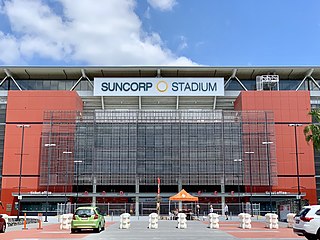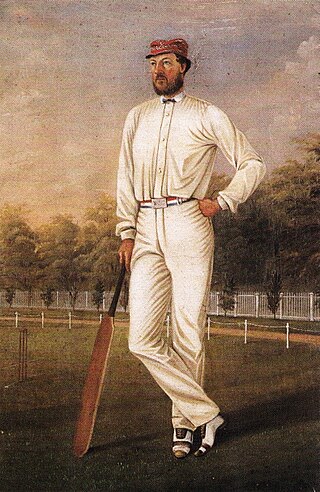
The Melbourne Cricket Ground (MCG), also known locally as "The 'G", is an Australian sports stadium located in Yarra Park, Melbourne, Victoria. Founded and managed by the Melbourne Cricket Club, it is the largest stadium in the Southern Hemisphere, the 11th largest globally, and the second largest cricket ground by capacity. The MCG is within walking distance of the city centre and is served by Richmond and Jolimont railway stations, as well as the route 70, route 75, and route 48 trams. It is adjacent to Melbourne Park and is part of the Melbourne Sports and Entertainment Precinct.

Docklands Stadium, also currently known by naming rights sponsorship as Marvel Stadium, is a multi-purpose sports and entertainment stadium in the Docklands area of Melbourne, Victoria, Australia. Construction started in October 1997 and was completed in 2000 at a cost of A$460 million. The stadium features a retractable roof and the ground level seating can be converted from oval to rectangular configuration.

The Melbourne Sports and Entertainment Precinct is a series of sports stadiums and venues, located in Melbourne, Victoria, in Australia. The precinct is situated around 3 km east of the Melbourne central business district, located in suburbs of Melbourne and Jolimont, near East Melbourne and Richmond.

Carrara Stadium is a stadium on the Gold Coast in Queensland, Australia, located in the suburb of Carrara.

The Brisbane Cricket Ground, commonly known as the Gabba, is a major sports stadium in Brisbane, the capital of Queensland, Australia. The nickname Gabba derives from the suburb of Woolloongabba, in which it is located. Over the years, the Gabba has hosted athletics, Australian rules football, baseball, concerts, cricket, cycling, rugby league, rugby union, Association football and pony and greyhound racing. At present, it serves as the home ground for the Queensland Bulls in domestic cricket, the Brisbane Heat of the Big Bash League and Women's Big Bash League, and the Brisbane Lions of the Australian Football League. It is also the secondary home of the Brisbane Broncos of the National Rugby League. The stadium will serve as the Olympic Stadium during the 2032 Summer Olympics and Paralympics, and for those events the stadium will be rebuilt.

Yarra Park is part of the Melbourne Sports and Entertainment Precinct, the premier sporting precinct of Victoria, Australia. Located in Yarra Park is the Melbourne Cricket Ground (MCG) and numerous sporting fields and ovals, including the associated sporting complexes of Melbourne and Olympic Parks. The park and sporting facilities are located in the inner-suburb of East Melbourne. In the late 1850s, many of the earliest games of Australian rules football were played at Yarra Park, which was known at the time as the Richmond Paddock.

Headingley Stadium is a stadium complex in Headingley, Leeds, West Yorkshire, England, comprising two separate grounds, Headingley Cricket Ground and Headingley Rugby Stadium, linked by a two-sided stand housing common facilities. The grounds are the respective homes of Yorkshire County Cricket Club and Leeds Rhinos Rugby League Club.

Melbourne is Australia's second largest city and widely considered to be a garden city, with Victoria being nicknamed "the Garden State". Renowned as one of the most livable cities in the world, there is an abundance of parks, gardens and green belts close to the CBD with a variety of common and rare plant species amid landscaped vistas, pedestrian pathways, and tree-lined avenues, all managed by Parks Victoria.

Sport is an important part of Australia that dates back to the early colonial period. Australian rules football, rugby league, rugby union, association football, cricket and tennis are among the earliest organised sports in Australia. Sport has shaped the Australian national identity through events such as the Melbourne Cup and the America's Cup. Australia also holds the record for the largest attendance at a Rugby Union match with almost 110 000 watching the Wallabies play the All Blacks in 2000.

Hindmarsh Stadium is a multi-purpose stadium in Hindmarsh, an inner western suburb of Adelaide, South Australia. It is the home of the Australian A-League team, Adelaide United.

Sport is a significant aspect of the Brisbane lifestyle. Activities range from the occasional international event, annual competitions, competitive leagues and individual recreational pursuits.
The state of Victoria, Australia, has a strong sporting culture and includes many popular sports.
Princes Park is an Australian rules football ground located inside the Princes Park precinct in the inner Melbourne suburb of Carlton North. Officially the Carlton Recreation Ground, it is a historic venue, having been Carlton Football Club's VFL/AFL home ground from 1897.
The Melbourne Sports and Entertainment Centre is a sports administration and training facility located in the Melbourne Sports and Entertainment Precinct in Melbourne, Australia. The facility opened in 1956 as an aquatic centre for the 1956 Olympic Games. In 1983, the Olympic-sized pool was replaced with a parquetry floor and the facility became Melbourne's home of numerous basketball events until 1998, most notably as the home venue for several National Basketball League teams including the North Melbourne Giants and Melbourne Tigers. The venue served as Melbourne's primary indoor concert arena from 1984 to 1988, until completion of the Rod Laver Arena.
The Australian Racing Museum is a horse racing museum in Melbourne, Australia, dedicated to Thoroughbred horses, jockeys and trainers. It was first set up at Caulfield Racecourse in 1981 and closed on 30 August 2003. It then moved to Federation Square on Flinders Street. In October 2010 the museum moved to the Australian Sports Museum at the MCG
The Motordrome, also known as the Olympic Park Speedway, the Melbourne Speedway or the Victorian Speedway, was a former speedway and Australian rules football ground located approximately on the site of the present day Melbourne Rectangular Stadium in Olympic Park in Melbourne, Victoria. The ground was primarily a speedway track, but also hosted football matches.

In 1870, Irish Australian artist William Handcock completed a portrait of Tom Wills, Australia's pre-eminent cricketer of the mid-19th century and one of the key founders of Australian rules football. It is unknown who commissioned the work or where it was kept after completion, but in 1923 it was acquired by the Melbourne Cricket Club through its then-secretary, Test cricket great Hugh Trumble.
The Hangar, also known for commercial reasons as The NEC Hangar, is the training facility and headquarters of Australian rules football club the Essendon Bombers. It is located in the north-west Melbourne suburb of Melbourne Airport and was opened in 2013.

The AFL Grand Final, which is the final premiership deciding match each season in the Australian Football League (AFL), has been played at the Melbourne Cricket Ground in Melbourne, Victoria every year since 1902, except on seven occasions when the ground was unavailable; and it is presently contracted to be played there until 2059. Despite the long-term stability in its location, and its natural fit as the largest capacity stadium in both Melbourne and Australia, the ongoing use of the Melbourne Cricket Ground has been controversial throughout its history.













